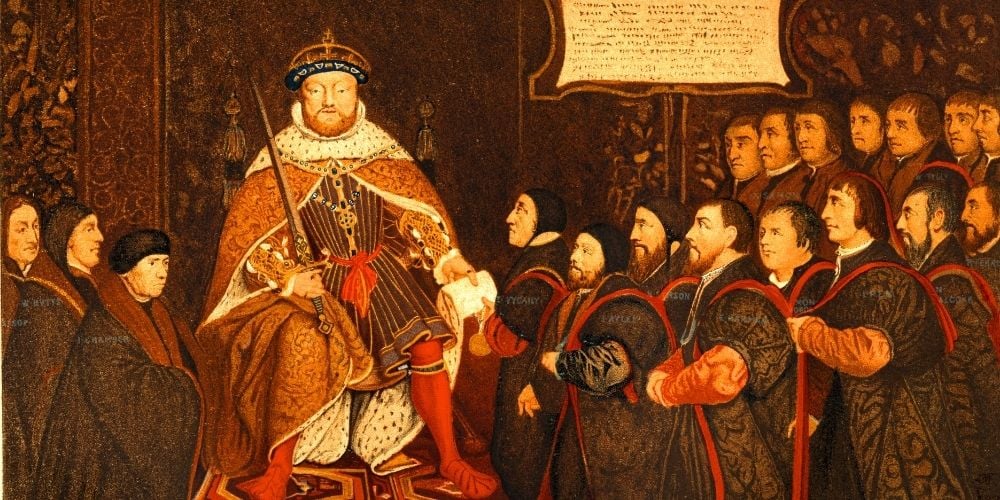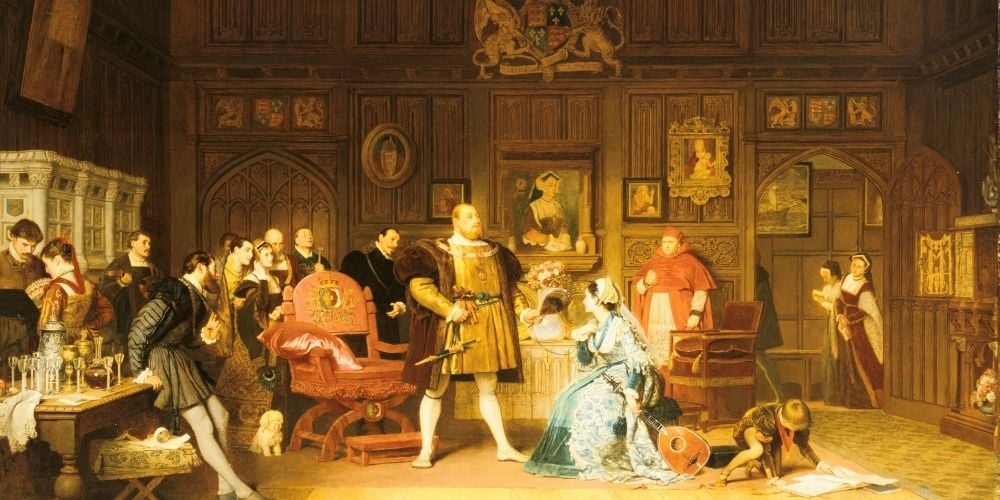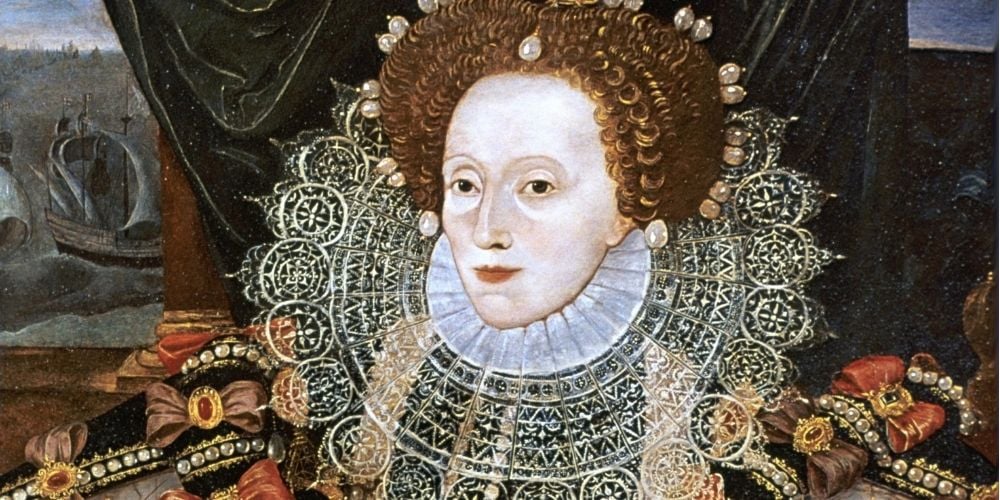Contents
- Who were the Tudor monarchs?
- Tudor kings and queens of England: Who was the first Tudor monarch of England?
- Tudor kings and queens of England: Who was Tudor King Henry VIII?
- Why did Henry VIII have six wives?
- When did Henry VIII die?
- Tudor kings and queens of England: What happened to King Edward VI?
- Tudor kings and queens of England: What happened to Jane Grey?
- Tudor kings and queens of England: What did Queen Mary I do?
- Tudor kings and queens of England: What did Queen Elizabeth I do?
- Why was Queen Elizabeth I called ‘the Virgin Queen’?
- What was the ‘Religious Settlement’?
- What was the Elizabethan era like?
- The legacy of the Tudor kings and queens of England
They’ve been dead for hundreds and hundreds of years, but even today it’s hard to escape the Tudor monarchs. They seem to be everywhere these days, on iPlayer, in bookshops, on stage and, like it or loathe it, in your lessons at school.
So, who were they and why do people still care so much about them after all these centuries?
This is our cheat sheet to give you a quick intro to one of British history’s craziest families!
Who were the Tudor monarchs?
The Tudors' ancestors came from Wales and England and the family were the Tudor kings and queens of England from 1485 to 1603. During their reign, many important events happened that changed England and the world forever. 👑
How many Tudor monarchs were there?
There were five or six Tudor monarchs depending on whether or not you include
poor Lady Jane Grey’s short time as Queen before she was arrested and executed.
Who were the Tudor monarchs in order?
Here is a list of the Tudor kings and queens including Lady Jane Grey. Because all these kings and queens come from the same family we call them a royal dynasty.
- 1485 - 1509 Henry VII
- 1509 - 1547 Henry VIII
- 1547 - 1553 Edward VI
- 10 July 1553 – 19 July 1553 Lady Jane Grey
- 1553 - 1558 Mary I
- 1558 - 1603 Elizabeth I
Tudor kings and queens of England: Who was the first Tudor monarch of England?
Ok, this gets complicated because there were lots of Henrys involved, but don’t worry, you’ll get the hang of it!
The first Tudor monarch of England was Henry the Seventh (Henry VII).
Henry’s Welsh grandfather, Owen Tudor, had secretly married a widow called Catherine of Valois. But Catherine wasn’t just any old widow. Her dead husband had actually been the king of England: King Henry the Fifth (Henry V)! Catherine and Henry the Fifth had a son called…wait for it…Henry! This Henry became King Henry the Sixth (Henry VI) at the age of nine months after his father died in 1422.
In 1455, Henry the Sixth was kidnapped (or….kingnapped? 😶) in a battle. This started a long conflict called the Wars of the Roses. This war was mainly between two families called the House of York and the House of Lancaster and their supporters. They fought over which family would get to pick England’s next king.
In the meantime, Owen Tudor and Catherine Valois’ had other children. Their son Edmund grew up and married Margaret Beaufort, a descendent of King Edward the Third (Edward III). Edmund and Margaret had a son who was given the totally unique and very special name…Henry 😐. Little Henry Tudor (he didn’t have a number yet) was related to royalty both through his mother and his father.
The Wars of the Roses kept going and the House of York and the House of Lancaster battled each other for 32 years over the right to be king. The fighting eventually left around 105,000 people dead which was around 5.5% of the whole population of England in the mid-fifteenth century. In a somewhat ridiculous turn of events, the war killed almost everyone from both families who could legally have become the king!
In 1485, the last fight of the Wars of the Roses took place at the Battle of Bosworth Field and at the last minute, there was a massive plot twist! Little Henry Tudor, the son of Henry the Sixth’s half-brother Edmund, suddenly returned from exile in France with an army of English, Scottish, Welsh and French fighters. He sneaked into Britain via Wales and with people from both the House of Lancaster and the House of York killed King Richard the Third (Richard III) and ended the war.
With all the other candidates for monarchy now dead, Henry Tudor became King Henry the Seventh (Henry VII), the first Tudor monarch!
After becoming king, Henry the Seventh worked to bring the Houses of York and Lancaster together. He married a Yorkian princess and started to unify the country after 85 years of civil war.
He died in 1509 and his son…Henry…😒…became King Henry the Eighth (Henry VIII), one of the most famous and infamous kings in English history.
Tudor kings and queens of England: Who was Tudor King Henry VIII?
Henry VIII is famous for having six wives, killing most of them and splitting England from the Catholic church through the English Reformation.
Henry’s older brother Arthur was supposed to be the next Tudor monarch but he died seven years before his father did. So, when Henry the Seventh died Henry was crowned king aged just 17. The pope allowed him to marry his dead brother’s wife, a Spanish princess called Catherine of Aragon. This was the first chapter in the sad story of the six wives.
Henry the Eighth wanted to copy the success of one of the earlier Henrys, King Henry the Fifth (Henry V) who had made England one of the strongest countries in Europe and conquered most of France.
Henry the Eighth invaded France himself in 1512 but failed. He tried again in 1513 and won some small battles, but it wasn't much compared to Henry the Fifth’s legendary victory at Agincourt. Over the years he fought more wars against France and also against Scotland, at that time not part of the UK.
Back home in England, he had other problems.
Why did Henry VIII have six wives?
When the monarch dies, their oldest child becomes the next king or queen. Like in most countries in England the first choice for the monarch was the oldest son of the previous king or another close male relative such as a nephew.
Until 2015, the monarch’s daughter could not become Queen unless she had no living brothers or nephews. So it was very important for royal marriages to produce male children who would become the heir to the throne.
Although Henry’s wife, Catherine, had six children, only a daughter called Mary survived. There had never been a female monarch in England before and Henry the Eighth was determined to have a son so that he could be sure he was not the last Tudor monarch.
In 1525, he decided a new wife might give him a son. So, as marriage in 15th Century England was controlled by the Catholic church, he had to ask the pope for a kind of divorce called an annulment.
The pope refused as he believed even kings had to follow the laws of the church. But Henry didn’t agree and decided the whole of England would divorce the Catholic church instead. Henry got parliament to make him head of the English church and he annulled his marriage to Catherine himself.
Who was Anne Boleyn?
In January 1533, the second Tudor king officially married Anne Boleyn, one of Catherine’s ladies-in-waiting (royal helpers).
This act of protest against the power of the pope meant England joined other places in Europe like Germany in something called the reformation and as a result, many people became protestant, (protest, protestant, get it?) and stopped following the rules of the Catholic church.
Henry also took the opportunity to close over 800 monasteries in England, Wales and Ireland and take their money. This may not seem like much of a big deal now, but in those days religion was really important and the Catholic church was nearly as powerful as the government. It was also seriously rich.
Henry’s decision set the scene for centuries of religious fighting that still continues today in places like Scotland and Northern Ireland.
Soon after they were married, Henry’s new wife Anne, gave birth to a daughter called Elizabeth. Poor Anne didn’t last long though as she was executed for treason and adultery in 1536.
Who was Jane Seymour?
Eleven days after he had Anne killed, Henry married one of her ladies-in-waiting, Jane Seymour.
In 1537, Jane finally gave Henry what he wanted when she produced a son and male heir for the cruel king. They called him Edward, but soon after his birth, Jane died. 😢
Who was Anne of Cleves?
Henry’s next wife was Anne of Cleves, a German noblewoman. This was a short one: Henry married Anne, then Henry quickly unmarried Anne six months later by getting another annulment. What happened in between is a bit unclear. Given who we’re dealing with here, it’s probably best not to ask to be honest.
Who was Catherine Howard?
After that came Catherine Howard (Anne Boleyn’s cousin!) who Henry married in 1540. Poor Catherine was just 17 when she married Henry, who was 49! 😱 Unfortunately, Catherine got caught cheating on Henry (can you blame her?) and he had her executed just like her cousin.
Who was Catherine Parr?
Henry’s last wife was a rich widow called Catherine Parr who had been married twice before. Catherine was an intelligent and well-educated woman who made sure Henry’s daughter Elizabeth was well educated too. Although she was almost arrested for her religious beliefs, Catherine outlived her tyrant husband, unlike most of Henry’s wives! 
When did Henry VIII die?
Henry died in January 1547 and Edward, his son with Jane Seymour, became King of England at nine years old.
Tudor kings and queens of England: What happened to King Edward VI?
Because King Edward the Sixth (VI) was so young, his uncle Edward Seymour made the decisions for him. Seymour didn’t do a great job and was soon arrested and had his head cut off in 1552.
Over the next year, Edward the Sixth became seriously ill. He was only 15 and did not have any children. He was worried that if he died and his half-sister Mary, a Catholic, became queen she would make England a Catholic country again. Because of complicated royal rules, he didn’t want his other half-sister, Elizabeth, to be queen either.
So, he made a plan for Lady Jane Grey, his first cousin once removed and great-granddaughter of Henry the Seventh, to become the next Tudor monarch if he died. He chose Lady Grey because she was a protestant and if she had any children the line of succession would be clear.
Edward died in the summer of 1553 without ever properly becoming king.
Tudor kings and queens of England: What happened to Jane Grey?
Lady Jane Grey became Queen of England on the 10th of July 1553. Unfortunately for Jane, Henry the Eighth's daughter Mary also wanted to be the monarch and she had a lot of support.
Nine days after being told she was queen, a powerful part of the government called the Privy Council betrayed Jane and said Mary was the queen instead. Jane was found guilty of high treason in November and executed in February 1554. She is known as the ‘Nine-Day Queen’ and was only 16 or 17 when she was killed. 😭
Tudor kings and queens of England: What did Queen Mary I do?
Queen Mary the first (Mary I) started out as a popular monarch but she soon made many enemies. As Edward had feared, she did try to make England a Catholic country again and ordered around 300 people to be burned alive just because they were protestant. This was when people started calling her ‘Bloody Mary’.
She married the catholic King Philip the Second (Philip II) of Spain. Some people, worried that he would take control of England, tried to rebel against the crown. Philip also talked Mary into fighting some expensive and failed wars against France.
In November 1558, four years after becoming the Fifth Tudor monarch Mary died aged 42. As she had no children, her half-sister Elizabeth was next in line for the throne.
Tudor kings and queens of England: What did Queen Elizabeth I do?
Anne Boleyn’s daughter Elizabeth was very smart and well-educated and spoke six languages.
After Mary was crowned queen, Elizabeth was kept prisoner for four years because the queen and her supporters were worried protestants would try to make her the queen of England instead.
When Elizabeth became the last Tudor monarch the country was strongly divided between Catholics and protestants and it was in a huge amount of debt.
She also faced the tough challenge of being only the second female monarch and on top of that, she wasn’t even married yet!
Why was Queen Elizabeth I called ‘the Virgin Queen’?
It was traditionally expected that the monarch would marry and have children who would become heirs to the throne.
However, marriage was a complicated decision for a queen. It could mean giving up some or all of her power to her husband or it could even cause wars in England or with other countries.
Although she was offered marriage by many European noblemen, including the King of Sweden, the Tsar of Russia and Mary’s widower King Philip the Second of Spain, she said no to all of them!
While she never got married, her childhood friend Robert Dudley was close to her throughout her life. He did once ask her to marry him, but she refused him too.
Because she never married, people started to call her ‘the Virgin Queen’.
What was the ‘Religious Settlement’?
While Queen Mary had tried to make England Catholic again, Elizabeth began the job of making English more protestant. She made many new rules like making all religious and royal officials swear an oath to be loyal to the new Church of England, she introduced a new prayer book that all churches had to use and forced everyone, catholic or protestant to attend church services.
These new rules were called the ‘Religious Settlement’. However, she never tried to make the country as protestant as much as Mary had tried to make it catholic. ⛪
What was the Elizabethan era like?
Elizabeth’s time as queen has been called a ‘Golden Age’ because England became a wealthy, cultured country that explored the world during her reign and many important events happened.
These were the days of the great English playwrights like William Shakespeare and Christopher Marlowe.
Sailor and explorer Sir Francis Drake sailed around the world between 1577 and 1581.
In 1585 Sir Walter Raleigh set up England’s first colony in America and called it Virginia in honour of Elizabeth’s nickname: ‘the Virgin Queen’. Many people see this as the beginning of the British Empire.
A few years later King Philip the Second of Spain sent the great Spanish Armada to attack England but were defeated by a combination of the Royal Navy and bad weather.
When her father Henry the Eighth closed all the monasteries he also took away a system that helped the most vulnerable people in society. To fix some of the problems her father had caused, Elizabeth introduced a law in 1601 which made every parish give money to help the poor, disabled and elderly.
The privateers were another group of people that Elizabeth helped. These were basically pirates who robbed gold from other ships, usually Spanish. The pirates also bought people from Africa and sold them as slaves. They became rich and shared some of their wealth with Elizabeth.
Elizabeth, who was the last Tudor monarch on the British throne, ruled as queen for 44 years. She left such a mark on history that we now call this time the Elizabethan period.
When Elizabeth died in 1603 aged 69, James the Sixth (James VI) of Scotland, who was her closest royal relative, became king of England and took the new name James the First (James I) of England.
The legacy of the Tudor kings and queens of England
Like all royal dynasties, the Tudors brought good things and bad things to the people they ruled over, but they definitely weren’t boring.
The country that the last Tudor monarch left behind was certainly a very different place from the one King Henry the Seventh took over after the Battle of Bosworth Field. England had a new religion, a new empire and a new understanding that a queen could rule every bit as well as a king.👑
Here at GoStudent, our History tutors are ready to take you on more fascinating adventures through time and space. Hit the link for a free trial class to help you learn more about history or prepare for exams like GCSEs or A-Levels!









